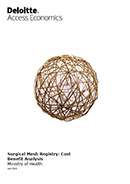
This report provides an analysis of the number and cost of mesh surgery, the cost of the burden of disease, the costs and benefits of clinical registries generally, and an estimated benefit-cost ratio for a surgical mesh registry in New Zealand. It responds to the Health Committee’s report, presented to Parliament in June 2016, which recommended that the Government investigate options for establishing and maintaining a centralised surgical mesh registry.
The cost of establishing and maintaining a full registry is estimated at $15 million over 10 years. With a potential return of $45 million in benefits from improvements in surgical quality estimated over the same time period, this gives a benefit-cost ratio of approximately 3:1.
The 3:1 figure takes into account all surgical mesh usage however. Around 80 percent of the information gathered and held in a full registry would relate to hernia repair procedures which are considered lower-risk compared to certain urogynaecological procedures (namely, pelvic organ prolapse [POP] and stress urinary incontinence [SUI]).
When looking only at POP and SUI surgeries the benefit-cost ratio is 1.5:1. The ratio could fall below 1:1 if the use of mesh in POP and SUI surgical procedures continues to decrease. A recent summary of reports, Adverse Events Reports Relating To Surgical Mesh Implants, published by Medsafe, found 823 SUI mesh devices were supplied in 2017, compared to over 2,100 in 2013. Surgical mesh has not been supplied for POP since regulatory action was taken in December 2017.
The report also estimates a register to take two years to design and implement and up to five years to return usable and actionable data.
While a national registry remains under consideration, as a more immediate step the Ministry is asking DHBs to hold and maintain local registers to collect information on surgeries involving surgical mesh. This will support the ability to identify those most at-risk, follow up with patients as needed and ensure robust informed consent processes are being followed.
More information on the Ministry’s wider surgical mesh work programme is available at Surgical mesh.
